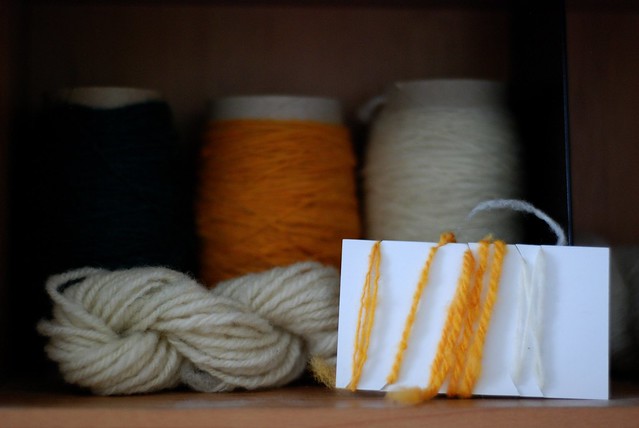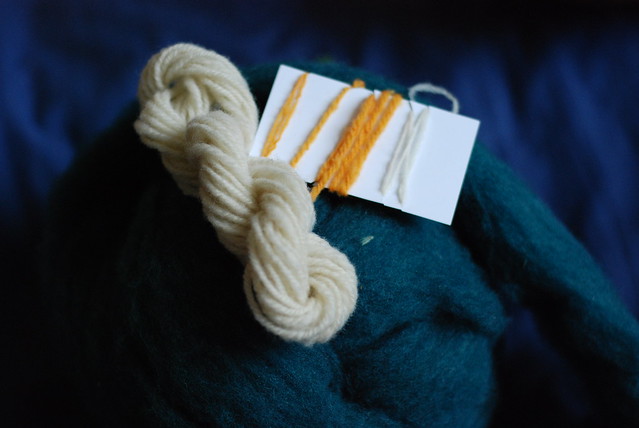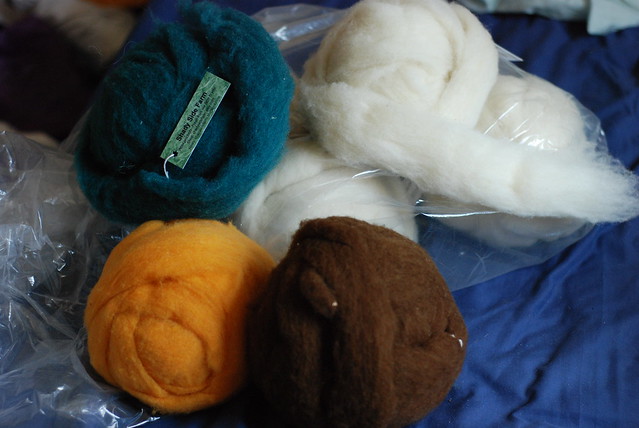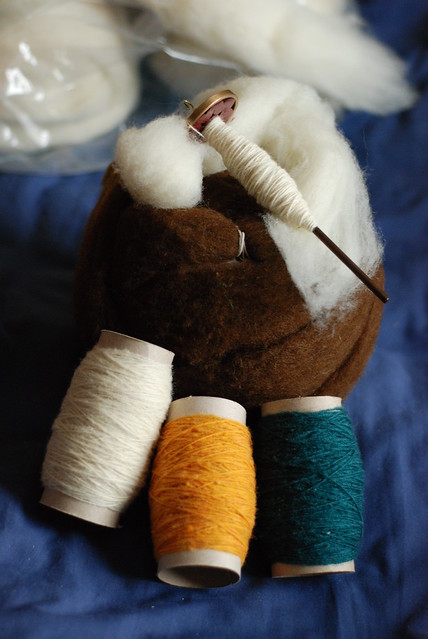I've just finished watching a Craftsy class - Curvy Knits with Marly Bird - and I thought I'd share some of my thoughts on it.
I'm a plus size, there's no denying that. And while I've knit a few sweaters before - and I'm in the middle of several more right now - I'm always worried that after all that work, things won't fit well. Sure, I know some of the principles involved to knit things that fit, but I'm always looking for new tricks - which is why I signed up for this class.
The class covers all the main topics for knitting a sweater for plus-size women - taking measurements, knitting a generous swatch, gauge & ease, choosing the right yarn and pattern, and finally getting down to brass tacks and modifying a pattern (covering shaping, short row bust darts, necklines and armholes/sleeves). There are also two 'bonus lessons' at the end - one on blocking, and the other (apropos of very little ;) on recommended knitting-related apps (iOS only).
Marly is a bicraftual designer - and she also does a class for Curvy Crochet.
 Marly is a very charismatic teacher, and just a fun person to watch! She manages to mix real, valuable info (like math for modifying sleeve caps) with funny anecdotes and a pleasant personality. She is also able to talk frankly - which is vital in a class like this, where we have to be honest about how our bodies are shaped in order to achieve a good fit. For instance, when she suggested taking measurements while wearing our 'good bra' - yep, I knew exactly what she was talking about!
Marly is a very charismatic teacher, and just a fun person to watch! She manages to mix real, valuable info (like math for modifying sleeve caps) with funny anecdotes and a pleasant personality. She is also able to talk frankly - which is vital in a class like this, where we have to be honest about how our bodies are shaped in order to achieve a good fit. For instance, when she suggested taking measurements while wearing our 'good bra' - yep, I knew exactly what she was talking about!
Another fun moment in the class is when she shows us how to make a duct tape mannequin, and Stephanie Japel makes a guest appearance :)
While there are a lot of tips in the class that are specific to bigger knitters, many of the modifications that Marly explains could be applied to any body type - for instance changing a neckline or adding in bust darts. I thought the class might cover body shapes like Amy Herzog's Fit to Flatter tutorials, but Curvy Knits takes a more intuitive than analytical approach to selecting patterns - you choose some garments out of your closet that you already know suit you well, and you use them as a guide for what you like.
(I just learned - apparently Amy's Knit to Flatter has its own Craftsy class, too!)
When I take a Craftsy class, I like to watch lots of lessons in one go and finish the class over a weekend or so. I think I must be an atypical Craftsy user, because some classes can get pretty repetitive when you watch several lessons back-to-back. I could have made a drinking game out of how many times Marly mentions she's bad at math, or that we can use video notes to bookmark things. (Though if I had done that, the math-heavy lessons towards the end would have been much harder...) ;)
The materials included for this class include a ton of worksheets for recording measurements and calculations, along with some extra information. The class materials also include 2 sweater patterns - Darlene Sue, a simple stockinette sweater used for illustrating bust darts and shaping, and Lacey Dream, an open lace cardigan in sportweight yarn.
The materials are all laid out nicely, easy to understand and packed with information. Plus, they're broken up into logical sections rather than all bunged into one huge PDF, which was how the materials in the Sizing Knitwear Patterns were formatted. The class materials summarize many of the key points of the class, so they would be useful to keep on your computer, tablet, or phone to refer to after watching the class videos.
The examples in the class are all for bottom-up, seamed sweaters, but the principles can easily be applied to any construction. It did throw me for a loop at once point, when I was only paying half-attention and she mentioned 'all 4 armholes of the sweater'... But no, it wasn't a sweater for an octopus, just two separate pieces for front and back.
I learned some helpful tips and tricks from this class, and re-enforced ideas that I already knew (yes, a lot of the time it just comes down to knitting a big swatch and doing the math...). And with Marly's bubbly teaching style, I had fun doing it. I would recommend this class! Check it out here.
~Joyuna
Craftsy class review - Curvy Knits with Marly Bird
Labels:
knitting,
review,
sweater,
tutorial
1 comments
![]()
Getting Technical
Since I'm spinning up (another) sweater from my big load of Polypay, I want to make sure the yarns I'm spinning are consistent. I have a problem with consistency - not so much over the short term (my yarn isn't necessarily thick-and-thin), but more over the long term. That is, the first ball of yarn I spin can be very different from the last ball I spin - in terms of thickness, as well as amount of twist.
One way to deal with this is to spin all the singles first and then ply the thick ones with the thin ones to help with consistency. Another way is to pay more attention as I spin - it's time to get technical.

Luckily, there is help out there. Ravelry, of course, is a wealth of information - some of my favorite spinning groups are Spin Tech, Advanced Spinning, and Spindlers.
But one thing that is really helping keep me on track is an app I just discovered - it's called iSpin Toolkit, and it's available for iOS. I wish it were on Android too, since I would love to have it on my phone, but luckily I do have an iPod Touch.
The app has a few different features - the most useful of which for me are the twist angle measure and the wpi gauge.
I do always measure wraps per inch when I'm skeining up a finished yarn, but I don't measure singles and it would break the flow of spinning to take out a ruler and wrap yarn around. This is more like those spinner's control cards - a series of horizontal lines and their wpi equivalent (white lines with a red border - when you can just see the red but can't see the white, you know you've got it right). It only takes a second to check that my single fits the same bar as it did at the start of the project - perfect!

So between the app, spinning all the singles before plying, my effort to increase my focus, and a little card with some samples to refer to, I'm hoping to keep this project consistent over the course of nearly 800g of fiber. Time will tell!
~Joyuna
Labels:
spinning,
yarn
0
comments
![]()
Polypay sweater! (I'm getting crazier by the minute)
I'm just back from visiting the USA to see my family - it was a great trip, albeit rather last-minute. Right before I set off, I decided to order a few things that would be hard to find back in the UK. And by 'a few things', I mean two pounds of wool...

The majority of it is Polypay wool roving (actual carded roving, not combed top - I'm not sure why so many Americans can't tell the difference) from Shady Side Farm. I was absolutely thrilled to find this shop - you might remember I encountered Polypay before at a workshop. And I quote...
"I would love to make a nice cushy (but still sturdy) sweater from this stuff. I'm not sure if I'll be able to get ahold of more Polypay in the future..."Well, I did! Shady Side's Polypay is softer than the fleece sample I worked with, better reflecting its Targhee ancestry. I cannot say enough good things about this wool - soft, bouncy, very easy to spin. And yes, I'm planning to spin a sweater out of it, so it's a good job I'm pleased with it!

I have a pound of natural undyed roving and three balls of dyed wool in teal, yellow, and brown. I think it's a really nice combination (for a striped or colorwork yoke). I haven't decided yet whether I'll dye the white yarn or leave it natural. Another color would be hard to coordinate with the set I've already got, but I don't wear white or cream very well. We'll see...
~Joyuna
Labels:
etsy,
etsy favorites,
spinning,
sweater,
yarn
4
comments
![]()
Sweater Crazy
I'm not sure what's come over me lately - all I want to knit are sweaters. I haven't finished any yet, but they're going quicker than I expected.
Sweaters, for me, are always more of a product knit than a process knit. I soon get bored of long stretches of a single stitch pattern, so for anything larger than a pair of socks, I need to motivate myself with the fact that it will be a really useful finished product.
There are practical considerations too - I don't really need more shawls or fingerless gloves. Even though I like knitting them, I already have more pairs than I will ever wear. A bunch of sweaters are more useful in that regard, plus the fact that since they're slower to knit, they'll pile up less quickly.
So a combination of those reasons, the stashbusting I'm taking on this year plus cleaning out my queue, and a general mood I'm in, has caused me to want to knit sweaters. Lots of sweaters.
Layter is coming along well. I've started the first sleeve, but I needed the tips for another project so it's temporarily on hold.

Katie is a quick, simple pattern with a beautiful colorwork band. It's an ideal way to use up leftover yarn that isn't enough for a whole sweater - the colorblock look is in, but I like how the simple stranding in this pattern softens the transition.

I've also cast on my first all-handspun sweater from some bouncy and soft grey wool. It definitely has a rustic feel, but I don't mind. I'm alternating two balls via the helix technique so that inconsistencies between balls are less noticeable.

~Joyuna
Labels:
knitting,
spinning,
sweater,
yarn
0
comments
![]()
Post your FOs and Win!
I love, love, love seeing the FOs people have made from my patterns. For me, it's the ultimate compliment that someone would use their precious knitting time and materials to work up something I designed.
Sometimes people make lovely modifications, or they take beautiful photos, and sometimes they just look really happy with their FO. And that makes me happy!
So if you've made something from one of my patterns, I want to give back. Head on over to my Ravelry group and find the Post your FOs and Win thread. Just post a picture of your FO - that's it. Then, I'll have a drawing and the winner gets a free pattern. :)
~Joyuna
Labels:
design,
knitting,
patterns
0
comments
![]()

 The Grateful Crane Shawl
The Grateful Crane Shawl Elven Slippers
Elven Slippers Russell Square Mitts
Russell Square Mitts Russell Square Tam
Russell Square Tam iTouch Jumper
iTouch Jumper Twisty Wristband
Twisty Wristband Mawata Pulsewarmers
Mawata Pulsewarmers